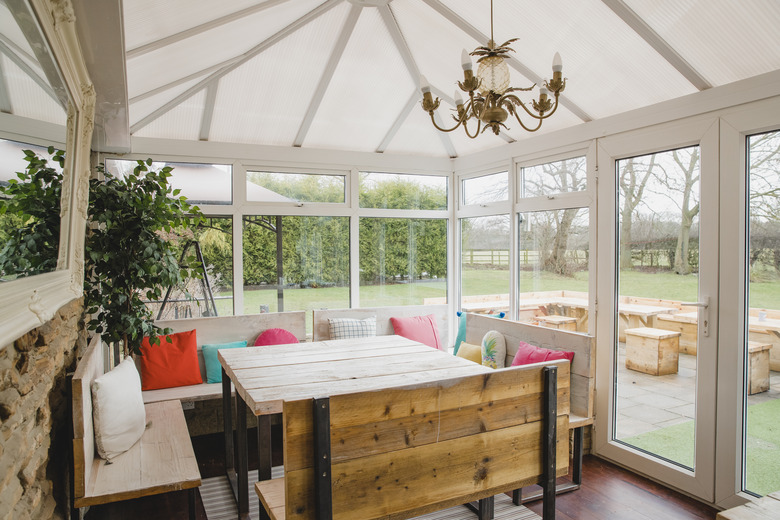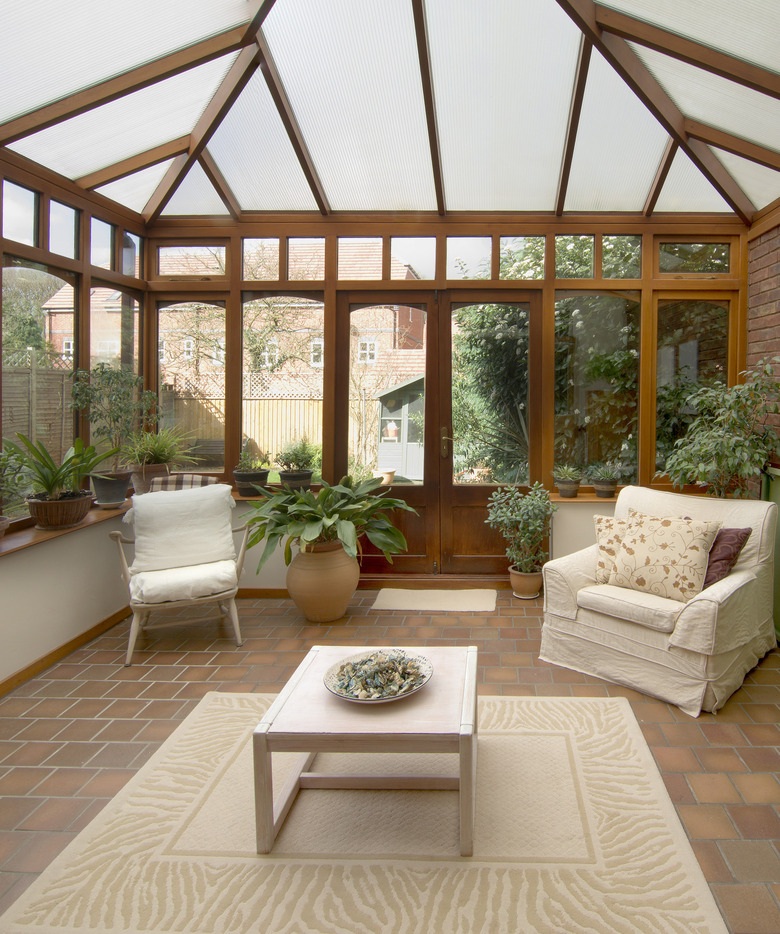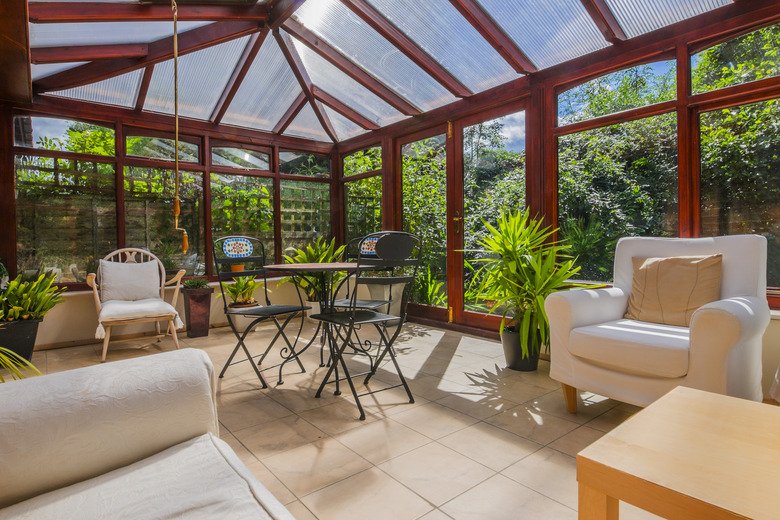3-Season Vs. 4-Season Room: Which Is Best For Your Home?
We may receive a commission on purchases made from links.
Many homeowners choose to increase living space by adding a sunroom to their home — creating a cozy space where they can drink their morning cup of coffee, enjoy a glass of wine in the evenings or have extra room to dine. Sunrooms are generally less expensive than a conventional room addition, and homeowners have the option of creating either a three-season room or a four-season room. The type of sunroom a homeowner chooses to build largely depends on what their goals are for the room's purpose and their budget.
Types of Sunrooms
Types of Sunrooms
There are a number of different types of structures called sunrooms, and the terminology can get murky. Basically, a sunroom is a space that has a lot of glass. In fact, in most sunrooms, the side walls are almost all glass. So, both a three-season room and a four-season room qualify as a sunroom because most of the wall space in these structures consists of glass. Three- and four-season rooms usually have solid roofs, although many contain skylights to let even more natural light inside.
Because of the roof, a three-season room and four-season room resemble a conventional room addition. They can either be custom built on-site or constructed from prefabricated kits from companies like Temo Sunrooms, Betterliving Sunrooms and Patio Enclosures. Sunroom kits are usually assembled by qualified contractors. Many manufacturers and contractors offer an array of options, so the final result is a semicustom sunroom. Some companies, however, offer DIY kits where you are the contractor.
Another type of sunroom that is called a solarium is made entirely of glass, including both the walls and the roof with the exception of the framing that holds the glazing in place. A term that often gets thrown into the sunroom mix is "screened porch," where a porch or an existing deck is screened to protect against insects.
3-Season vs. 4-Season Room
3-Season vs. 4-Season Room
The names "three-season room" and "four-season room" describe the innate differences between the two structures. A three-season room is designed to be enjoyed when the weather is nice, which is spring, summer and fall in most places. In some very warm climates, a three-season room may be uncomfortable during the hottest part of the summer. A four-season room, however, is habitable all year.
A four-season room can be used all year because it is constructed much like a regular room addition. It is served by an hvac system, and the structure itself — the glazing, framing and roof — is more energy efficient than the structure of a three-season room.
In many cases, the heating and cooling system from the main house can be extended into the four-season room. Another option is to install a ductless minisplit air conditioner for the sunroom. These systems consist of an interior air handler and a condenser-compressor that is installed outside. Many minisplit systems can supply both cooling and heating.
Because there isn't a heating and cooling system, three-season rooms must be separated from the rest of the house, so homeowners reach the space through a door. Four-season rooms can be open to the rest of the house.
Considerations for a Sunroom
Considerations for a Sunroom
A sunroom addition can offer a variety of uses, and your plans for the new space can help determine the type you choose. Because of the large amount of glazing, both types provide extra living space that is designed to provide extensive views to the outside, but a four-season room can be enjoyed all year.
Year-round use means the four-season space can be permanent, serving as a family room, home office, dining space or even an exercise room. You can do all those things in a three-season room, but you will need to move the activity into the main house during the room's off season.
A sunroom is usually a backyard addition. All that glass lets you enjoy nature from the comfort of an inside space, but if you have an unobstructed view, then the neighbors may be able to see in. So, it is important to consider the privacy aspects of the addition.
The cost of a sunroom addition can also play a part in your decision. A three-season room can cost between $10,000 and $50,000 for the materials and labor. A four-season room can cost from $20,000 to as much as $80,000. The extra cost goes into the heating and cooling equipment as well as the beefed-up energy package in the frame.
A four-season room provides livable floor space that will be included in the square footage count of the house should you put the house on the market. A three-season room may be attractive to buyers, but to be included in most real estate listings as livable square footage, the room has to be habitable 365 days a year.
Some three-season sunrooms use very light materials and can be installed on an existing patio or deck, but the regulations can vary. Be sure to check with the local building department about the need for a foundation. Many places require that sunrooms be installed on a slab foundation. You will need a building permit for the structure, and you must abide by setback requirements.
Structures for Sunrooms
Structures for Sunrooms
Sun spaces vary from manufacturer to manufacturer, but generally, one of the differences between three-season and four-season rooms is the composition of the materials. Many three-season rooms have single-pane glass, while four-season rooms often have double glazing with low-emissivity coatings on the windows. Low-e coatings are microscopic films that prevent heat loss from inside the structure as well as cut down on heat gain from outside.
Vinyl, aluminum or wood frames hold the wall glazing in place. In better products, the interior of aluminum frames contains thermal breaks, which are spacers or insulation that help stop the flow of energy from inside to outside. Weatherstripping around doors and where the glazing meets the frames prevents air infiltration. Both types usually include screening so that the windows can be opened to let in fresh air.
Designs vary, but some four-season sunrooms have short knee walls along the bottom of the wall, and the rest of the wall is glass. The solid wall allows for running electrical wiring and baseboard heat throughout the sunroom. The framing system of some sunrooms has internal raceways for running wiring.
Roofing options include gable roofs and shed roofs, the type that consists of a single surface that slopes away from the house. The roofing system helps the sunroom blend in with the original house, especially when the roofing material matches the rest of the house. In four-season rooms, the roof is usually insulated.
Sunroom Temperature Control
Sunroom Temperature Control
Even if a sunroom contains top-of-the-line windows and insulation, the interior may become uncomfortably hot on very sunny days. If you think that may be a problem, choose a glazing system that will block as much solar heat as possible. There are glass coatings and tints that can do that. Some systems also block ultraviolet rays from the sun that can fade fabrics and carpeting.
Ceiling fans can produce a slight breeze that will make you feel cooler. They work for four-season rooms that may be air conditioned as well as three-season rooms. Be sure that the structure can support a ceiling fan. Ceiling fans also help during cold weather because they force warm air near the ceiling back down into the living space.
In humid areas, a dehumidifier can help keep the room's humidity low, and opening windows on opposite walls can help create cross-ventilation. Operable skylights in three-season and four-season rooms can vent unwanted heat. You can also get shades that are custom designed for your sunroom windows. Motorized versions connected to light sensors or timers can lower the shades when you are not home.


